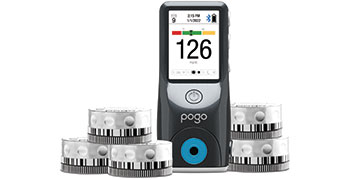US Pharm. 2022;47(11):15-16.

Helping Patients Overcome Barriers to Regular Blood Sugar Checking
Diabetes, the seventh leading cause of death in the United States, is a chronic autoimmune disease in which an individual’s blood glucose (BG) level is abnormally high. The CDC estimates that 37.3 million Americans had diabetes in 2019.* Nearly half of people with diabetes, however, are not attaining their recommended hemoglobin A1c (HbA1c) target. This leads to hundreds of thousands of emergency department and hospital visits annually. Regularly checking blood sugar is therefore an important part of diabetes management. However, traditional BG meters raise barriers to checking that lead to poor adherence with monitoring recommendations, which directly correlates to higher HbA1c levels. Fortunately, there is another option: automatic BG monitoring. POGO Automatic, which eliminates separate lancets and separate glucose strips, is the only FDA-cleared BG monitoring system with 10-test cartridge technology.
* CDC. Prevalence of both diagnosed and undiagnosed diabetes. National Diabetes Statistics Report. www.cdc.gov/diabetes/data/statistics-report/diagnosed-undiagnosed-diabetes.html.
Poor Adherence Leads to Higher HbA1c
Regularly monitoring blood sugar is an important component of diabetes management. Poor adherence to checking regimens with a BG meter is directly correlated with higher HbA1c levels, but many people do not check their glucose as often as recommended. Traditional fingersticks present barriers that hinder people from checking their glucose levels as often as they should. The three most common barriers are glucose strip handling, lifestyle disruptions, and glucose-checking complexity. Studies show that 88% of people have glucose strip–handling issues, such as glucose strips being contaminated when they are removed from their vial. Moreover, 69% of people face lifestyle disruptions with traditional BG meters, including trouble checking their glucose on the go or finding it cumbersome to carry everything that is needed. Furthermore, 74% of people want BG checking to be simple. Although newer options such as continuous glucose monitoring (CGM) address some of these barriers, not everyone is interested in CGM or has access to it. Consequently, fewer than 10% of people with diabetes use CGM.
Advantages of Automatic BG Monitoring
Now, there is another option for checking blood sugar that represents a new choice for patients and creates an entirely new BG-testing category: Automatic BG Monitoring (ABGM). POGO Automatic is the first and only FDA-cleared BG monitoring system with 10-test cartridge technology, eliminating the need for separate lancets and glucose strips.
With the POGO Automatic Monitor and Cartridges, all patients have to do is click the cartridge door open, pop the multi-test cartridge into the monitor, and close the cartridge door. Patients can put their POGO Automatic in their purse, pocket, or wherever they choose and easily take it with them when they are out with friends, at work, or running errands. Whenever they are ready to check their glucose, all they have to do is press the power button, place their finger on the test port, and hold it there until the image on the screen tells them to lift their finger. Then, POGO Automatic analyzes the sample and displays the reading. POGO Automatic’s One-Step Testing means that patients do not have to handle separate lancets or separate glucose strips, and they can automatically lance and test their BG level in seconds, without everyone noticing.
POGO ABGM System Indications, Insurance Coverage
POGO Automatic Blood Glucose Monitoring is indicated for use by adults and adolescents aged 13 years and older. POGO Automatic benefits all patients with diabetes, especially frequent testers, such as those taking insulin. BG meters are expected to have an accuracy of plus or minus 15% compared with the value in a laboratory-based reference system. As shown in the cartridge package insert, POGO Automatic meets that expectation.
POGO Automatic is covered by a growing number of commercial payers, and patients can bring their prescription to most retail chain and independent pharmacies in the U.S. To ensure access for patients with commercial insurance, Intuity Medical has a Prescription Savings Co-Pay Card Program for use at retail pharmacies. Patients can visit presspogo.com/savings-program to download a POGO Automatic Prescription Savings Card. POGO Automatic is also eligible for purchase with FSA or HSA dollars online at shop.presspogo.com. For additional questions, patients can visit presspogo.com or call the patient support team at 1-855-IMI-POGO.
The content contained in this article is for informational purposes only. The content is not intended to be a substitute for professional advice. Reliance on any information provided in this article is solely at your own risk.
To comment on this article, contact rdavidson@uspharmacist.com.






